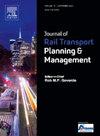Onboard train speed optimization for energy saving using the prediction of block clearing times under real-time rescheduling
Abstract
Energy-saving driving is crucial during railway operation, especially in case of disturbances that require timetable rescheduling. This paper presents a method for the dynamic onboard tuning of energy-efficient speed profiles after the real-time train rescheduling process under a fixed block signaling system for mixed traffic. Similar to the idea of connected driver advisory systems, trains constantly communicate with a central traffic management system. After the rescheduling process, this system provides recommended time corridors for the passing of block signals that depend on the predicted clearing times of the block sections. These recommendations are then used for individual energy optimization of single train runs by avoiding unnecessary braking in front of block signals and maximizing cruising distances. The method is tested and evaluated on a representative line segment of the ELVA, the Railway Signaling Lab at RWTH Aachen University under realistic conditions. Energy consumptions are compared for different prediction time horizons at which the recommendations are available to the train's onboard system. In the examined test case of two trains, the energy-consumption could be decreased by up to 53% compared to operation without any rescheduling system. Thus, the proposed method is able to reduce energy consumption significantly.

 求助内容:
求助内容: 应助结果提醒方式:
应助结果提醒方式:


